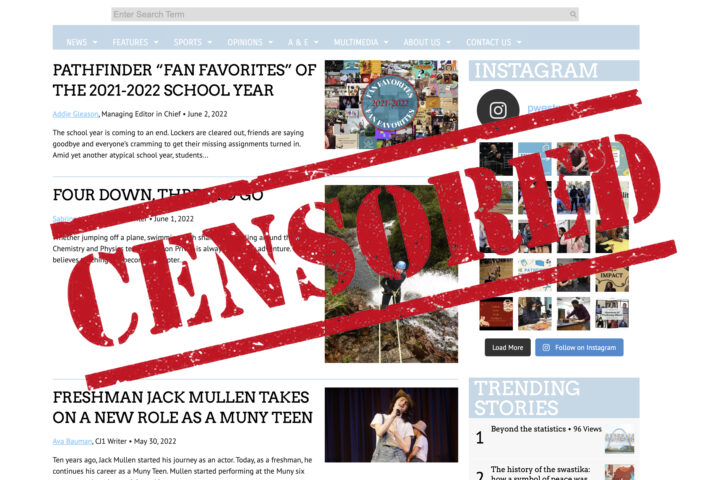This story is syndicated from The Black and White, the newspaper of Walt Whitman High School in Bethesda, MD. The original version of the story ran here.
An intriguing trend has recently taken root across social media platforms — “Girl Dinner.” “Girl Dinner” is an online trend defined as an assemblage of food items so low in effort that it might not be considered a proper or well-rounded meal. Amid the “Girl Dinner” boom, many have taken to labeling daily dismissable activities with “girl” in front, such as “Girl Math” and “Hot Girl Walks,” all of which are growing online trends seeded from TikTok. The internet is currently flourishing with the romanticization of ordinary behaviors and concepts. These trends labeled “girl” in front often have negative connotations, which can reduce women to their gender.

As clips of strange food arrangements captioned “Girl Dinner” flood TikTok, one question, in particular, arises: if these preparations of food are seemingly chaotic and innutritious, why would people label the trend as feminine? Due to a historical root in misogyny, these trends correlate “feminine” trends with deficient concepts. The gendering of everyday things perpetuates harmful stereotypes and undermines the achievements of women. Shying away from labeling with negative connotations to a specific gender will eliminate the breeding ground for harmful stereotypes.
The unnecessary gendering of everyday concepts is not a new phenomenon, and gendering terms as feminine have a historically negative connotation. People in the 1950s and 60s would put “lady,” “girl” or “woman” in front of job titles to undermine women’s accomplishments and discredit their work.
“It grew out of lady doctor, and lady pilot,” said Gender Studies teacher Linda Leslie. “Why are we gendering these terms? Have we not moved on?”
“Girl Dinner” can feature “meals” that contain a single grape or a bowl of carrots. Because of the trend’s satirical tone, these incomplete meals are accepted without questioning the reality of their nutritional emptiness.
The controversy under the name “Girl Dinner” can deepen the relationship between eating disorders and insecurity with femininity, which is harmful to all sexes.
“It started as a funny trend but suddenly it had a restrictive side and became competitive and I know that eating disorders a lot of the time are competitive, so it just encourages that sort of mindset and culture,” high school junior Jasper Murray said.
The movie industry typically solely portrays insecure young women as people with eating disorders. By perpetuating the inaccuracy of this demographic, “Girl Dinner” reinforces the stereotype of women being insecure about their bodies. This seemingly fun trend deepens a negative stereotype of women when it could have remained ungendered.
Despite 60% of women earning advanced degrees, the notion that they are less capable and less educated persists through this viral trend. What began as “Girl Dinner” later transformed into a new trend: “Girl Math.” “Girl Math” originated as a way for women to joke about internal calculations to justify their purchases, centering on internal feminine logic instead of “math.” Some women excuse small purchases by claiming that anything under $5 is free. Others validate their spending by saying that paying cash for something is free. The “Girl Math” videos reinforce the idea that women are inherently bad at math and lack intelligence.
“Girl Math is just illogical math and therefore implying the logic of women to be illogical as well, which is exactly the stereotype we have been trying to move away from,” high school junior Anabel Richard said.
“Girl Math” inevitably relates to historical barriers to women in education, which is when these stereotypes originated. Moving farther away from the stereotype of women being bad at math will allow women to continuously progress toward equality and grow in their professional and personal lives. When the public has spent so much time trying to achieve gender equality and take women seriously in male-dominated spaces, maintaining these degrading stereotypes of women through trends can set progress back.
“You run like a girl, you throw like a girl, you shoot like a girl, you argue like a girl,” Leslie said. “It’s all because of misogyny, and of the historical underrepresentation of women in STEM.”
Supporters of these trends claim it’s a form of empowerment that makes women feel united in their “shortcomings.” For women, the daily experience of having to prove oneself is constant. In a perfect world, women are allowed to gather in this subsection of media to create a space where one doesn’t need to spend an hour cooking a beautiful meal to be satisfied or save every dollar they have to invest. Instead, women can enjoy their money and spending. However, the negativity attached to these trends completely devalues the original purpose. People can represent the ideals of togetherness in ways other than posting videos of “bad” dinners and stating inaccurate mathematical statements on the internet to describe the “mind of a woman.” People on social media should start connecting “girls” to positive concepts and ideas to defy ongoing stereotypes and empower women.
Disguised as harmless, the “girl” phenomenon perpetuates systemic oppression and misogyny. Trends like these misrepresent women, and globalizing and paying mind to these stereotypes ultimately does more harm than good. Women can find community and belonging in ways other than applying the label “girl” in front of things with a negative connotation.
The narrative must be rewritten to connect female empowerment to positive daily experiences. They are moving on from the constant “girl” and “girl” that will allow women to empower themselves without the entanglement of harmful stereotypes.



